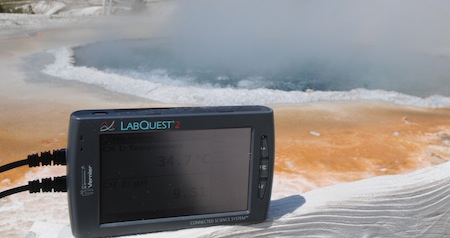3 Quarks Daily Science Blogging Prize
By Lauren Jonas, NSTA Assistant Executive Director
Posted on 2012-05-30
Hello Fellow Bloggers and NSTA Members,
I came across this contest from Discover magazine and wanted to share. We have some talented folks on here, and some of you may want to try it. If you enter, please share your entry with us (you can put it under the NSTA Reports category if you like, which is the category for news and general blogs) and let us know if you win! Click here for more information.
Hello Fellow Bloggers and NSTA Members,
Chemistry Now, carbon, captured: carbon dioxide
By admin
Posted on 2012-05-30
 As a college student in the 70s wracking up science courses for my secondary teaching degree, scientists’ warnings of accelerated global warming made a believer out of me. Recently, looking at photos of Mt. Kilimanjaro or glaciers in Chile taken over the last forty years, I still find it curious that there are doubters out there. Perhaps they just don’t understand the science behind it.
As a college student in the 70s wracking up science courses for my secondary teaching degree, scientists’ warnings of accelerated global warming made a believer out of me. Recently, looking at photos of Mt. Kilimanjaro or glaciers in Chile taken over the last forty years, I still find it curious that there are doubters out there. Perhaps they just don’t understand the science behind it.
This learning package—Carbon, Captured: Carbon Dioxide, developed by NSTA, NBC Learn, and NSF—emphasizes the chemistry behind global warming and how scientists research its causes and changes over time. Begin using the materials in this package as part of a chemistry or physical science unit on chemical bonding, and then progress to real-world applications. Or use the package as the core of a cross-science discipline unit with a still-timely environmental theme.
Then, don’t forget to let us know how the materials worked for you!
–Judy Elgin Jensen
Spring 2010 photo of Mt. Kilimanjaro by John Haylett.
Video: “The Chemistry of CO2: Carbon Dioxide,” explains and illustrates the bonding of the carbon and oxygen molecules into CO2 and describes its role in the Earth’s atmosphere and how changing levels of CO2 can affect the temperature on Earth.
Video: Part of NBC’s Changing Planet series, “Black Carbon” explains how these particles are polluting the air and causing serious health and environmental concerns for people around the world.
Video: Part of NBC’s Changing Planet series, “Thawing Permafrost” explains how this result of global warming is cause for concern beyond the far north, because the carbon released from thawing permafrost could raise global temperatures even higher.
Video: Part of NBC’s Changing Planet series, “Ocean Acidification” shows how marine organisms in the pristine Arctic and Antarctic oceans are being impacted by increased amounts of carbon dioxide being absorbed by the waters.
Video: Part of NBC’s Changing Planet series, “Survival of Trees” highlights how Dr. Joy Ward at the University of Kansas investigates ancient tree specimens from the Ice Age to see how trees in the past have adapted, helping her to understand how trees may adapt today and in the future in light of global warming.
Video: The NBC News report “Producing Biofuels May Worsen, Not Lessen, Carbon Dioxide Emissions,” highlights a study about the true impact of biofuel production on the environment.
Video: The NBC News report “First-Ever Image of a Molecule,” shows the picture of a molecule of pentacene taken by researchers at IBM.
Middle school lesson: This lesson explores carbon and calcium carbonate and describe how the carbon cycle is at work in the environment.
High school lesson: In this lesson, students set up experiments to help them better understand CO2 and its presence in and impact on the carbon cycle and the environment.
Please tell us what you think. Click here to complete a 15-minute survey. Thanks.
You can use the following form to e-mail us edited versions of the lesson plans:
[contact-form 2 “ChemNow]
 As a college student in the 70s wracking up science courses for my secondary teaching degree, scientists’ warnings of accelerated global warming made a believer out of me. Recently, looking at photos of Mt. Kilimanjaro or glaciers in Chile taken over the last forty years, I still find it curious that there are doubters out there. Perhaps they just don’t understand the science behind it.
As a college student in the 70s wracking up science courses for my secondary teaching degree, scientists’ warnings of accelerated global warming made a believer out of me. Recently, looking at photos of Mt. Kilimanjaro or glaciers in Chile taken over the last forty years, I still find it curious that there are doubters out there. Perhaps they just don’t understand the science behind it.
Chemistry Now, chemistry of fear and fright
By admin
Posted on 2012-05-29
 Before Samuel L. Jackson battled snakes on a plane and before Indiana Jones infamously muttered “I hate snakes,” there was my Mom, who was terrified of them. Growing up on a small midwestern farm, Mom often helped with the spring plowing. She would carry a hoe with her on the tractor just in case she plowed up a nest of snakes. Then she could quickly jump off and chop them up! And we never got through the strawberry-picking season without the shout to “Get the hoe!” because she’d seen some hapless garter snake among the leaves. You’d think that as a farmer she would have understood their importance in the ecosystem. But her fear, however irrational, was just too great!
Before Samuel L. Jackson battled snakes on a plane and before Indiana Jones infamously muttered “I hate snakes,” there was my Mom, who was terrified of them. Growing up on a small midwestern farm, Mom often helped with the spring plowing. She would carry a hoe with her on the tractor just in case she plowed up a nest of snakes. Then she could quickly jump off and chop them up! And we never got through the strawberry-picking season without the shout to “Get the hoe!” because she’d seen some hapless garter snake among the leaves. You’d think that as a farmer she would have understood their importance in the ecosystem. But her fear, however irrational, was just too great!
You might have a similar fear—one of roller coasters, spiders, heights, or public speaking. How does your body respond when you find yourself face-to-face with it? Find out in the Chemistry of Fear and Fright, part of the Chemistry Now series of lesson packages produced by the partnership of NBC Learn, NSF, and NSTA. Perhaps use the Common Phobias photographs as a bellringer slide show. But be careful … you and your students could become too frightened to continue!
P.S.
Need a team project? Listen to the 1938 War of the Worlds radio broadcast (available on the Internet for free download) and use the historical perspective included here as a springboard for projects, discussions, and research into fear, mass hysteria, and the power dramatization.
–Judy Elgin Jensen
Photo of vertical drop SheiKra roller coaster by Joshua Kaufman
Video: “Chemistry of Fear and Fright,” explains what fear is, chemically: a series of responses in the brain and body caused by the release of two hormones that ready the body for “fight or flight” action.
Video: The NBC animation “Word Roots: Phobos,” creatively shows derivations of the Greek root phobos, meaning “fear.”
Video: The news report “New Ways to Treat Phobias” gives students insights into kinds of phobias and how they can be treated.
Video: The historical perspective “Orson Welles Recalls ‘War of the Worlds’ Broadcast 40 Years Later” describes how the broadcast scared the public and Orson Welles reaction to the public panic.
Middle school lesson: This lesson guides students in exploring how the human body reacts to fear triggers.
High school lesson: In this lesson students investigate how Daphnia respond to stresses and make an analogy to how the body reacts to fear triggers.
Please tell us what you think. Click here to complete a 15-minute survey. Thanks.
You can use the following form to e-mail us edited versions of the lesson plans:
[contact-form 2 “ChemNow]
 Before Samuel L. Jackson battled snakes on a plane and before Indiana Jones infamously muttered “I hate snakes,” there was my Mom, who was terrified of them. Growing up on a small midwestern farm, Mom often helped with the spring plowing. She would carry a hoe with her on the tractor just in case she plowed up a nest of snakes. Then she could quickly jump off and chop them up!
Before Samuel L. Jackson battled snakes on a plane and before Indiana Jones infamously muttered “I hate snakes,” there was my Mom, who was terrified of them. Growing up on a small midwestern farm, Mom often helped with the spring plowing. She would carry a hoe with her on the tractor just in case she plowed up a nest of snakes. Then she could quickly jump off and chop them up!
Rise and Shine: A Practical Guide for the Beginning Science Teacher
By Nancy Dunbar
Posted on 2012-05-29
 Stepping into the ‘real world’ as any type of new teacher is daunting; doing so as a science teacher can be even more difficult, with science-specific issues like lab safety and management added to the mix of responsibilities. Rise and Shine: A Practical Guide for the Beginning Science Teacher is an easy-to-use, comprehensive support system for any new science teacher. This book answers questions that relate to teaching in general, like classroom management, student engagement, and professional development, but also contains a wealth of information on challenges specific to teaching science. Chapter sections such as “Science Reading and Writing” and “Boosting Science Vocabulary” emphasize specific skills science students should learn and suggest the best ways to teach them. Tidbits of advice from experienced teachers throughout the book add real-life wisdom and tips to make the beginning of a career in the classroom as smooth as possible. Rise and Shine is the perfect resource for science teachers who are just starting out, who are in a new teaching situation, or who are mentors looking to support a new science teacher. NSTA Press® Extras has a list of Rise and Shine: A Practical Guide for the Beginning Science Teacher Online Extras that relate to the chapters in the book and include links to documents and online resources such as a sample 6th grade syllabus, safety guidelines from NSTA, and tips for setting up a science classroom. Rise and Shine is one of several guidebooks for new teachers available from NSTA Press, including Help! I’m Teaching Middle School Science and You Want Me to Teach What?! Sure-Fire Methods for Teaching Physical Science and Math.
Stepping into the ‘real world’ as any type of new teacher is daunting; doing so as a science teacher can be even more difficult, with science-specific issues like lab safety and management added to the mix of responsibilities. Rise and Shine: A Practical Guide for the Beginning Science Teacher is an easy-to-use, comprehensive support system for any new science teacher. This book answers questions that relate to teaching in general, like classroom management, student engagement, and professional development, but also contains a wealth of information on challenges specific to teaching science. Chapter sections such as “Science Reading and Writing” and “Boosting Science Vocabulary” emphasize specific skills science students should learn and suggest the best ways to teach them. Tidbits of advice from experienced teachers throughout the book add real-life wisdom and tips to make the beginning of a career in the classroom as smooth as possible. Rise and Shine is the perfect resource for science teachers who are just starting out, who are in a new teaching situation, or who are mentors looking to support a new science teacher. NSTA Press® Extras has a list of Rise and Shine: A Practical Guide for the Beginning Science Teacher Online Extras that relate to the chapters in the book and include links to documents and online resources such as a sample 6th grade syllabus, safety guidelines from NSTA, and tips for setting up a science classroom. Rise and Shine is one of several guidebooks for new teachers available from NSTA Press, including Help! I’m Teaching Middle School Science and You Want Me to Teach What?! Sure-Fire Methods for Teaching Physical Science and Math.
Surveying video and lesson plan use
By admin
Posted on 2012-05-29
 We need your help!!! NBC Learn, NSF, and NSTA have teamed up to bring you video / lesson plan packages that explore various science concepts. But we want to know how we can make them better and more usable in your classroom. Your feedback will point us to improvements. Please settle in with a cup of coffee or a soda, tell us about your video usage, and what you would like to see in lesson plans. You’ll need about 15 minutes, and that includes time to watch a sample. And then, take advantage of all of the free materials available now!
We need your help!!! NBC Learn, NSF, and NSTA have teamed up to bring you video / lesson plan packages that explore various science concepts. But we want to know how we can make them better and more usable in your classroom. Your feedback will point us to improvements. Please settle in with a cup of coffee or a soda, tell us about your video usage, and what you would like to see in lesson plans. You’ll need about 15 minutes, and that includes time to watch a sample. And then, take advantage of all of the free materials available now!
NGSS May 2012—suggestions for K-2 educators reviewing the draft
By Peggy Ashbrook
Posted on 2012-05-27
 We all have an opportunity to comment on the draft of the Next Generation Science Standards! The last date to comment on this draft is June 2nd, just days away. This is a busy time of year for teachers but we can contribute to the usefulness of the NGSS by reviewing and commenting using the survey provided on the NGSS website. I am going to lay out some of my thoughts on the standards for grades K-2, and hope that you will add your comments, either here or in the NSTA Learning Center Forum, in addition to using the survey. By reviewing this May draft of the standards we can contribute, at least in the areas where we feel comfortable.
We all have an opportunity to comment on the draft of the Next Generation Science Standards! The last date to comment on this draft is June 2nd, just days away. This is a busy time of year for teachers but we can contribute to the usefulness of the NGSS by reviewing and commenting using the survey provided on the NGSS website. I am going to lay out some of my thoughts on the standards for grades K-2, and hope that you will add your comments, either here or in the NSTA Learning Center Forum, in addition to using the survey. By reviewing this May draft of the standards we can contribute, at least in the areas where we feel comfortable.
I found it easier to have the “How to Read the Next Generation Science Standards” page open while I read through the standards. It also helped me to remember that the standards, called performance expectations, are made of three dimensions: Science and Engineering Practices, Disciplinary Core Ideas, and Crosscutting Concepts. In my first read I did not read through the “Foundation Boxes” where these dimensions are listed. But it really helped me to read them the second time I read through the K-2 NGSS. Take a look, join the discussion and when you are ready, give your feedback using the survey which will go to the state and other teams that will work on the next draft.
Click here to go to the Next Generation Science Standards website to see the May 2012 draft. Resources are also available on the NSTA Learning Center website (free registration for all). Two documents were particularly helpful for me:
PDF of the NGSS May 2012 Draft (with page numbers and TOC added by NSTA)
The pdf on the NGSS website does not have page numbers but the one on the NSTA site does. The early childhood portion for grades K-2 is through pdf page 11, marked page 10 on the NSTA paginated version.
The bare-bones name doesn’t describe this document which offers a timeline, suggests questions to consider as you read and discuss the May 2012 draft of the NGSS, and includes the NGSS Matrix of Standards by Discipline and Grade Level (also available as a separate single-page document at the Learning Center).
The “How to Read the Next Generation Science Standards (NGSS)” document explains the layout but I still needed to look through the standards and then go back to the “How to Read” document again before I felt comfortable with the layout.
I look forward to discussions here and on the NSTA Learning Center’s forums. Here are a few of my thoughts after my first reading of the K-2 section of the draft NGSS, and without the benefit of talking it over with other educators. I offer them as a starting point and hope that you will correct any mistakes. (I label the Performance Expectations, Science and Engineering Practices, Disciplinary Core Ideas, and Crosscutting Concepts in each comment to make it easier to find what I’m commenting on.)
On the layout of the draft:
I find the format unifying. The connections to the Common Core Mathematics and English Language State Standards will make it easier to integrate the curriculum and see where teaching math and ELA concepts support the practice of science and engineering, and vice versa. It is helpful to have the Science and Engineering Practices listed with each draft standard (performance expectation). I can see how the practices are the foundation for what I teach. The Disciplinary Core Ideas and Crosscutting Concepts are also listed and I like not having to switch back and forth in a document to see how the different dimensions relate to each other and to my current curriculum.
Wishing preK was included:
The Science and Engineering Practices that are the foundation for many of the K-2 performance expectations contain the wording: “…in grades K-2 builds on prior experiences and progresses to…” The Framework acknowledged that “…the capacity of young children—from all backgrounds and socioeconomic levels— to reason in sophisticated ways is much greater than has long been assumed.” It seems to me that standards for preK could be included in this document.
Adding wording for “Experiencing the Natural World” as it relates to the Kindergarten standard, K.SPM Structure and Properties of Matter:
Although there is no performance expectation for Experiencing the Natural World, some of the standards, core ideas, and crosscutting concepts require a foundation of experience in nature. The standard K.SPM Structure and Properties of Matter section “d.” states: “Distinguish between opinions and evidence in determining whether objects in a given set occur naturally or are manufactured.” The Disciplinary Core Idea PS1.A: Structure and Properties of Matter states in part: “Matter can be described and classified by its observable properties (e.g., visual, aural, textural), and by its uses, and by whether it occurs naturally or is manufactured.” The Influence of Engineering, Technology and Science on Society and the Natural World states: “Every human-made product is designed by applying some knowledge of the natural world and is built by using natural materials…”
Children must have experience with the natural world to be able to distinguish what is natural and what is manufactured by people, and they must have knowledge of the natural world to be able to apply it when designing a product. I would like to see this experience explicitly listed somewhere in the NGSS.
Kindergarten performance expectation, K. WEA Weather
Several of my preK students have become “regulars” at recording the amount of rainfall in the rain gauge on the playground. This experience helps them construct a relationship between the presence of dark clouds and rain. They are beginning to understand that scientists make measurements to collect data. One 4-year-old asked me why the rain gauge does not have a “zero” to mark the bottom of the line of numbers on the gauge. This comment shows he knows that if you don’t have any, you have “zero” and that zero marks a starting point on a measurement tool. Young children can also notice patterns in clothing choices if they graph the number of people wearing shorts/sweaters/coats on a regular basis throughout the year. This data represents temperature changes that can be documented without using a thermometer.
I have a question about the K. WEA performance expectation. In part “d”, should kindergarteners “Analyze weather data to determine that some kinds of severe weather are more likely to occur than others in the local region”? I think it should be written without “severe,” as in: “Analyze weather data to determine that some kinds of weather are more likely to occur than others in the local region.” This would include all weather, severe or mild. This is not to avoid talking with young children about severe weather but because severe weather may not occur often enough to see any pattern.
I’d like the clarification statement for K. WEA Weather-d. to include a comparison between “normal precipitation” and “drought” as one of the examples of severe weather.
The Assessment Boundary limits this comparison to the students’ local region—very appropriate for young children to learn about their local region before learning about distant regions.
Is this wording awkward? Performance Expectation 1.SF Structure and Function-c
In performance expectation 1.SF Structure and Function-c, the wording “external inputs” seems awkward.
I wonder why only “external” body parts are part of this Disciplinary Core Idea LS1.A and “smell” and “taste” are not listed in along with “see” and “hear.”
In performance expectation 1.LS Light and Sound
Part “a”, “Investigate to describe that objects can be seen only when light is available to illuminate them,” states a difficult concept to teach. Is it more appropriate for older grades, second or third?
In performance expectation 1.PC Patterns and Cycles
I would like to see the Clarification Statements for Part “a” expanded a bit to include other events. For Part “a”, a caterpillar eating a leaf is an example of a quickly occurring natural event, and the life cycle of a butterfly is an example of a slower event. For Part “b”, the day and night cycle is a very appropriate example of a cycle that young children can easily observe.
In performance expectation 2. ECS
I would find it helpful to have the Clarification Statements specifically refer to how water as ice can move Earth materials. Ice is noted in the supporting Disciplinary Core Idea ESS2.C.
About 2.SPM Structure, Properties, and Interactions of Matter.
This performance expectation seems a little disjointed. Part “c”, “Provide evidence that some changes caused by heating or cooling can be reversed and some cannot” is about the property of melting temperature, a specific property of matter, while Parts “a” and “d” are about properties in general. Also, Part “b” is about designing an object from a set of pieces, which may be written to help students build understanding that matter is composed of smaller pieces. If so, the Clarification Statement could reflect this.
Performance expectation 2. PP Pushes and Pulls
The Assessment Boundary for Part “a” and “b” could be even further spelled out for easier understanding: “Simultaneous pushes and pulls to be along a single line; pushes and pulls to be between objects in contact.” By mentioning only simultaneous pushes and pulls, it makes it seem that single pushes and pulls are not to be taught. I might say, “Limit assessment of simultaneous pushes and pulls to those that are along a single line—not in more than one line; pushes and pulls to be between objects in contact, not at a distance.” I’m being a little picky but this is a difficult topic to state simply.
I think it is very appropriate that the term “gravity” is not part of a Performance Expectation until third grade (3.IF Interactions of Forces) even though many children learn the term as early as preschool but with very limited understanding.
So those are my beginning thoughts. After I get to discuss the NGSS with other educators, such as yourself, I’ll fill out the survey—by June 2nd. I welcome your comments, and corrections. What do you think?
Is the format easy to understand?
What would help you understand the meaning more easily?
Are the concepts that you think young children should have some experience with in grades K-2 addressed in this draft?
Peggy
The resource-full teacher (revisited)
By Mary Bigelow
Posted on 2012-05-24
Some of you may remember the good ol’ days when you had to trek to a library or subscribe to multiple publications to catch up on science and education topics. I must confess that back then, it was difficult for me to find the time to spend a few hours in the library (plus travel time) to find the publications and to read them all right there and then. 
Fast forward to today, when it’s easy to bring selected resources right to your computer, cell phone, or tablet. It seems we now have the opposite situation–so much information it’s hard to know where to start.
Most organizations, institutions, and agencies have electronic resources that they share, free of charge. You can choose from several format options: newsletters delivered via e-mail, Facebook updates, Tweets, notices that are linked to a website with the information, RSS feeds, or podcasts. Check the websites of your favorite organizations, museums, university or college science departments, publications, or scientific agencies to see what they offer. Look for the networking logos to see what options you have. If you’re not sure where to start, here are some that I subscribe to, “like,” or follow:
- NSTA has both Facebook and Twitter links. There’s also an overview of many resources (including the latest posts to the forums) via the NSTA dashboard.
- Edutopia from the George Lucas Educational Foundation is one of my favorites for seeing teachers and students in action.
- SmartBrief and the Inservice blog from the Association for Supervision and Curriculum Development (ASCD) with educational news on a variety of topics from newspapers, professional publications, bloggers, and reporters. You don’t have to be a member to subscribe to this service!
- The National Science Foundation provides articles and other updates, including the “Latest News” section with articles that could be easily be shared with students.
- Scientific American has news articles, podcasts, lesson ideas, and blogs on the latest research.
- Breaking News from NASA
- Discover Magazine’s Not Exactly Rocket Science
- ISTE Connect for updates on instructional technology
- Free Technology for Teachers has great suggestions and is one that I look at regularly.
- Smithsonian, American Museum of Natural History, The Exploratorium…the resources and information from museums, parks, zoos, and science centers are endless.
Do I read everything in these newsletters, tweets, blogs, and articles? No, I’ve learned to be a gourmet rather than a glutton! I scan the titles and look for those that sound interesting or relevant. And sometimes I look for topics I know little about, just to learn more.
Do you have your own favorites to share?
Some of you may remember the good ol’ days when you had to trek to a library or subscribe to multiple publications to catch up on science and education topics. I must confess that back then, it was difficult for me to find the time to spend a few hours in the library (plus travel time) to find the publications and to read them all right there and then. 
Teaching Science Through Trade Books
By Nancy Dunbar
Posted on 2012-05-24
 The use of trade books to supplement science textbooks in the classroom is a proven, effective strategy to combine science and reading education for children in a way that is genuinely interesting to them. In the new NSTA Press book Teaching Science Through Trade Books, authors Christine Anne Royce, Emily Morgan, and Karen Ansberry compiled 50 entries from their popular “Teaching Through Trade Books” column in NSTA’s journal Science and Children. These engaging, ready-to-teach lessons each highlight two trade books and suggest two related activities, one for K–3 and one for grades 4–6. Topics in the collection cover a wide range of science disciplines, including Engineering, Technology, and Applications of Science; Physical Science; Life Science; and Earth and Space Science. Trade books such as How is a Pencil Made? and The Man Who Walked Between the Towers are sure to grab students’ attention, introduce science ideas, and ensure that the subsequent lessons are enjoyed and absorbed. Teaching Science Through Trade Books is a valuable resource for teachers as it offers appealing, effective activities to accompany beloved and educational children’s books. To read the free chapter “Cloud Watchers,” click over to the book’s page in the Science Store and look for the link next to “Read inside.” The NSTA’s Picture Perfect Science Lessons Series is another good resource for teachers looking to combine reading and science lessons. The Children’s Book Council and NSTA annually develop a list of Outstanding Science Trade Books for Students K–12. It is a great resource for trade books teachers could use in the classroom.
The use of trade books to supplement science textbooks in the classroom is a proven, effective strategy to combine science and reading education for children in a way that is genuinely interesting to them. In the new NSTA Press book Teaching Science Through Trade Books, authors Christine Anne Royce, Emily Morgan, and Karen Ansberry compiled 50 entries from their popular “Teaching Through Trade Books” column in NSTA’s journal Science and Children. These engaging, ready-to-teach lessons each highlight two trade books and suggest two related activities, one for K–3 and one for grades 4–6. Topics in the collection cover a wide range of science disciplines, including Engineering, Technology, and Applications of Science; Physical Science; Life Science; and Earth and Space Science. Trade books such as How is a Pencil Made? and The Man Who Walked Between the Towers are sure to grab students’ attention, introduce science ideas, and ensure that the subsequent lessons are enjoyed and absorbed. Teaching Science Through Trade Books is a valuable resource for teachers as it offers appealing, effective activities to accompany beloved and educational children’s books. To read the free chapter “Cloud Watchers,” click over to the book’s page in the Science Store and look for the link next to “Read inside.” The NSTA’s Picture Perfect Science Lessons Series is another good resource for teachers looking to combine reading and science lessons. The Children’s Book Council and NSTA annually develop a list of Outstanding Science Trade Books for Students K–12. It is a great resource for trade books teachers could use in the classroom.
NSTA Chapters and Associated Groups: Want to know more about D&O Insurance?
By Teshia Birts, CAE
Posted on 2012-05-24
We are featuring another guest blogger, Kenneth Huff. Kenneth is the President of The Association of Presidential Awardees in Science Teaching (an NSTA Associated Group) and he recently investigated the benefits of Directors and Officer insurance and the protection it can provide for APAST.
 With many associations continuing to experience the affects of a tenuous economy evidenced by declining memberships and decreased revenues, why then are some associations pondering adding another disbursement to their ledger? Especially when it comes to purchasing insurance. As an officer or board member in your association, perhaps you are thinking we can’t afford this now. However, investigating details about Directors and Officers (D&O) insurance may instead have you thinking we can’t afford not to have this now.
With many associations continuing to experience the affects of a tenuous economy evidenced by declining memberships and decreased revenues, why then are some associations pondering adding another disbursement to their ledger? Especially when it comes to purchasing insurance. As an officer or board member in your association, perhaps you are thinking we can’t afford this now. However, investigating details about Directors and Officers (D&O) insurance may instead have you thinking we can’t afford not to have this now.
D&O insurance is protection against a “breach of duty” in the discharge of your service to the association. This type of policy protects one if a member feels they have been discriminated, believes the assets of the association were not used properly, or if a member suspects the association of an error, omission, or misleading statement. D&O insurance pays for actual or alleged wrongful actions including a failure to provide a service.
Ones homeowners and automobile insurance cover personal liability including bodily injury or property damage. Umbrella policies can also be used for this purpose in which you the insured are liable, such as someone falling in your driveway due to snow and ice. Neither homeowners/automobile nor umbrella policies provide protection for alleged or actual wrongful action.
D&O insurance covers damage from wrong decisions and not bodily injury or property damage. If you are a board member and the association has a claim filed against it, once the assets of the association are depleted the board is then personally liable for costs incurred to settle the suit. That means your personal assets may be used. Do not assume because you are a volunteer you are not liable. Volunteer service is no defense for improper or wrongful acts. While you may be very committed to your association and its mission, you may need to ask yourself if you are willing to put up your house for it.
Kenneth Huff, President
The Association of Presidential Awardees in Science Teaching
We are featuring another guest blogger, Kenneth Huff. Kenneth is the President of The Association of Presidential Awardees in Science Teaching (an NSTA Associated Group) and he recently investigated the benefits of Directors and Officer insurance and the protection it can provide for APAST.
Kicking the tires on the LabQuest 2 and its Connected Science System
By Martin Horejsi
Posted on 2012-05-23
A couple weeks ago, Vernier released their Graphical Analysis App for iOS providing a functional wireless interface with their LabQuest 2 and the iPad.
We took a LabQuest 2 and an iPad running Vernier’s Graphical Analysis App for a quick spin in Yellowstone National Park this weekend to explore the connectivity and general features. We found the LabQuest 2 an impressive combination of capabilities further dissolving the interference of the operation of the technology while preforming real-time data collection.
So in a nutshell…
Our data collection was focused on the temperature and pH. Initial runs used the LabQuest 2 as a standalone device. The sensor auto detect was quite fast, and the default display options were appropriate. Although the backlighting had to be turned to its brightest to see the display in full sunlight, glare was not as much of a problem as it is with the iPad’s glass surface. On a side note, polarized sunglasses have much less of an effect on the LabQuest 2 compared to the iPad that is only readable when viewing the screen in landscape mode requiring the use of the screen rotation lock switch to maintain viewing consistency.
As a quick data collection tool, the user interface and speedy startup of the LabQuest 2 is simple and fast enough eliminate the device as a barrier to use. Turn it on and go. Past probeware interfaces often required moments to minutes of setup that were sometimes just enough to prevent data collection on a whim.
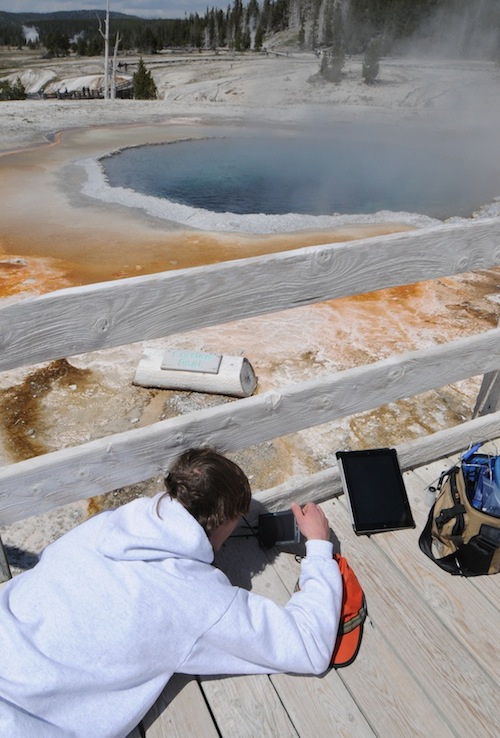
Yellowstone National Park provided the LabQuest 2 and iPad and almost infinite number of exciting data collections.
Connecting to the iPad was surprisingly quick given that the LabQuest 2 provides a scanable QR code for iPad to use rather than entering the IP address by hand. Using a QR code reading App (we used the App called Scan) and the iPad camera, the connection was made in a split second. Literally. And this is all done completely independent of an established wireless network as there were no other wi-fi networks nearby because our preliminary testing arena was none other than the geyser basin at the Old Faithful complex of Yellowstone Park.
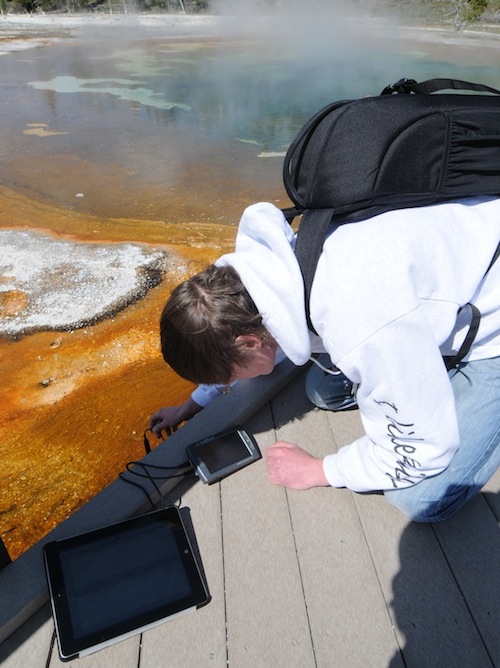
Yellowstone provided large number of data collection opportunities without breaking any of the park rules. Unlike the person in the video below from our trip to the Park last year
[youtube]http://www.youtube.com/watch?v=iu5p2HPyOwg[/youtube]
The high school student using the LabQuest 2 had never used a probeware interface before today, and only marginally experience with an iPad. The probes were dropped into the runoff streams from various geysers and hot pools. In one particular case, a small geyser eruption sprayed the LabQuest 2 while we watched the data stream on the iPad from a safe distance. It would make sense that sealing the LabQuest in a plastic bag as it feeds its radio waves to nearby iPads would dramatically increase the scope of outdoor data collection.
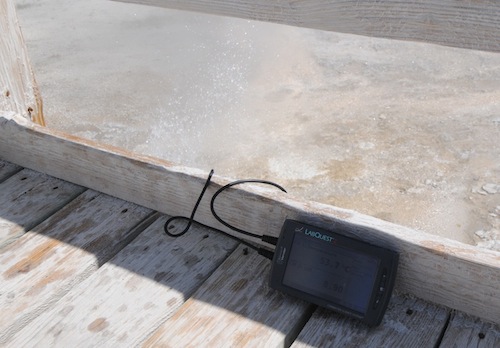
An erupting geyser splashes hot water on the boardwalk and LabQuest 2. We were standing a safe distance away watching the real-time data stream wirelessly to our iPad.
We did permanently lose the connection between the LabQuest 2 and iPad when both were turned off and then restarted, but when the LabQuest 2 was left on, the iPad had no trouble reconnecting after it would time-out or be shut off (but not fully shut down). However, the QR code made any necessary reconnection almost instantaneous. We had to shade the LabQuest 2’s screen to get the iPad QR code scanner to read.
Now that we have a better understanding of the connectivity-side of the LabQuest 2 and Graphical Analysis App, a more in-depth and deliberate inspection of the operating potential is needed. So stay tuned.
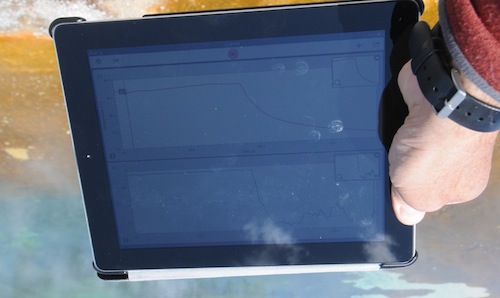
The large screen of the iPad is leveraged by the LabQuest 2 providing plenty of discussion real estate in a colorful multitouch environment.
It seemed obvious that the LabQuest 2 would be a real game changer in the data collection space, but after our field test, it seems more that the LabQuest 2 has invented an entirely new game. However, ultimately it falls on the teachers and students to truly imagine the potential of this technology. In fact, I’d even go so far as to say that human imagination is the main limit of Vernier’s Connected Science System right now.
A couple weeks ago, Vernier released their Graphical Analysis App for iOS providing a functional wireless interface with their LabQuest 2 and the iPad.
We took a LabQuest 2 and an iPad running Vernier’s Graphical Analysis App for a



